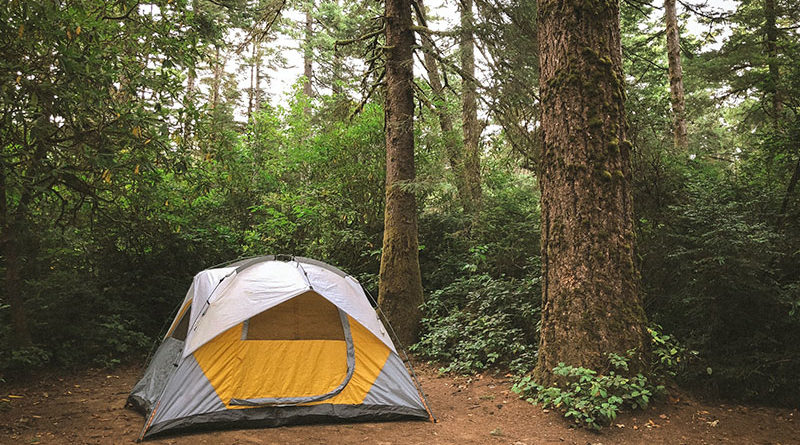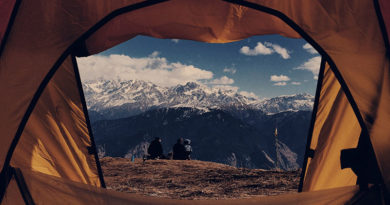7 Ways to Insulate A Tent For Summer
It’s difficult to get a good night’s sleep while setting up camp in the summer. That hot tent will prevent people from getting the rest you require to prepare for yet another full day of outdoor adventure.
Every camper desires to go camping in the summer whenever the hours are long and sunny. However, warmer days may heat your tent, making it unbearably hot during the day and at night, making it difficult to sleep.
The sun’s rays are trapped by the tent, trapping heat. And then, once heated, it might be difficult to cool down the interior, which can rapidly destroy your camping experience. Therefore, we have brought you simple ways that you can utilize for how to insulate tents for summer. So, no more bad summer camping days!!
What Exactly Is Tent Insulation?
Tent insulation refers to the process of maintaining heat inside a camping tent. It is carried out for both summertime and winter camping trips.
Insulating your tent allows heat to accumulate until your body is warm and comfortable. The procedure of insulating a tent will need you to construct a barrier that will keep the heat inside.
If things are done in a proper manner, then you will successfully raise the heat inside your camping tent. It will provide you with all the necessary protection from the cold weather.
What Causes Cold in Camping Tents?
Because you’ll be learning how to insulate tents for summer, it’s only natural that you must be familiar with how they become chilly. It occurs due to cooler temperatures that may result due to rain, snow, hailstorm, wind, etc. Human body functions are also responsible for causing cold temperatures inside camping tents. If body warmth and breath are not properly ventilated, it may cause condensation inside the tent. As a result, water droplets will form that may reduce the temperature inside your tent.
Now, you might be wondering how to insulate tents for summer by controlling the temperature within them. But, first, let’s see why insulation is important.
Insulation’s Importance
Winter and summer camping both necessitates the use of insulation. Even during summer, evenings and nights can be quite chilly, and days can be unbearably hot.
Therefore, a temperature-controlled tent will enable you to have a peaceful night’s sleep. However, the usefulness of tent insulation extends beyond just comfort.
The risks involved with cold or warm temperatures can be lethal. Even little risks might have long-term consequences. In hot weather, heat rashes, dehydration, heatstroke can cause concern. In the cold winter, hypothermia and frostbite are two conditions to be concerned about.
Technological developments have indeed made it simpler to remain warm, and emergency services are always just a phone call away. However, you should be aware that certain situations are beyond your control.
How to Insulate Your Tent for Summer Camping
Begin with the Tent itself
When camping in the heat of summer, you’ll want to think carefully about the tent you’re bringing. In hot weather, a 2-season tent works perfectly. In addition, tent material matters; despite being heavier, a cotton tent will reduce heat loss than tents made of nylon or polyester.
Similarly, a huge cabin-style tent containing mesh windows also works best for summer camping. Ventilation is essential, and the windows will assist keep the camp cooler by allowing air in; the more room there is, the easier it will be for the air to flow. If there is no chance of rain, remove the rainfly to avoid trapping heat within the tent and limiting air circulation.
If your tent is simple to up and dismantle, consider erecting it when the sun sets and dismantling it in the morning. This prevents the tent from overheating during the hotter daytime hours while retaining heat during the night.
Place a ground cover (plastic sheet or footprint) between the earth and your tent when erecting it. Rather than your tent’s floor taking heat from the ground, the ground cover will absorb it.
To maintain a cool temperature inside the tent during summer, ensure that adequate air is moving inside. To keep your camp cool, open all vents, ports, and rain traps. When looking for a tent, look for one with a mesh window. When you open the mesh window, it ensures that no bugs enter. It is critical to select a tent with an adequate ventilation system.
Many tents include rainfly, but you may remove them if there is no chance of rain. Furthermore, rain flies are unnecessary when you have a tarp or a reflecting sunshade. The rain fly that comes with tents is rather thick, and they may hold a significant amount of heat while the temperature rises inside the tent.
Find some shade and start digging.
When your tent is exposed to sunlight, it will warm up and stay warm throughout the day. Putting your tent in a shady area can help you keep it cool because it will not be in the sunshine. Another factor to consider while erecting your tent is the wind direction.
If possible, set your tent such that the wind blows directly through the mesh windows. Keep your windows open during the day to allow heat to escape. If possible, dig a two-foot-deep trench for setting up your tent. Putting your tent partially underground can help it stay cooler.
Bring a campground fan, including an extension cable, if you’re staying at a campsite with electricity. If you don’t have access to electricity, consider a battery-powered fan with a voltage of 6 or 12 volts. Many fans may be linked to your tent; position your fan to blow over you while completely avoiding blowing at the tent wall.
Placing a bag of ice in a shallow dish right in front of the fan will assist in chilling the air. Either use a large dish for this purpose to accommodate melting water from the ice, or you will be required to empty the dish regularly. You may also use a portable tent air conditioner if you have access to electricity.
Make use of a reflective tarp.
A sunshade can be made with reflective sheeting or a reflective space blanket. Place a few of them on your tent’s rooftop or tie them to the trees that surround it, leaving a few feet between each layer. This will direct the sun’s rays away from your tent, reducing the amount of heat that penetrates and becomes trapped within.
There is no reason to avoid camping throughout the summer months. You can keep your tent cool on summer family vacations with a little effort. In addition, the capacity to obtain a decent night’s sleep means that you can spend the night outside all year.
In the summer, insulating your tent with a tarp or umbrella is a good idea. In the summer, the intense rays of the sunlight heat the tent. Because the sun is the major heat source in your tent, concealing it will be quite useful. By attaching the tarp to tree branches, you can effortlessly drape it over your tent.
Furthermore, you can place some fence posts on the floor and tie the tent to the poles to form a strong base. Sunshades are typically sold with poles or posts; you do not need to purchase them separately. Finally, when covering your tent, allow some gap between the tarp and the tent to allow air circulation.
Choosing the Proper Tent
Getting the correct tent is the first step toward remaining cool if you’re going camping in the summer. You’ll need a breathable tent with plenty of airflow. Summer tents are composed of a lightweight material than all-season tents, and they will include multiple mesh windows and waterproof flaps that may be left open during the day.
Polyester tents are a wonderful choice for camping in extremely hot weather since they are UV resistant. Nylon is another fantastic option since it allows more warm air to exit from the tent than polyester.
Cotton tents are still colder than polyester or nylon tents, though they’re thicker and more difficult to put up. If you have the money, go with a bigger cabin-style tent with many mesh windows. You’ll receive even more ventilation with the larger room, with cold air moving to keep the interiors cool.
Hence, if you are planning camping this summer, you should reconsider the tent you’ll be bringing with you. In the summer, the material of your tent will make a large difference in maintaining your cool. First, you must verify that your tent’s fabric is absorbent and contains sufficient vents to allow appropriate air circulation.
Look for lightweight tents with net windows and weather flaps. For the summer, materials such as polyester or nylon may be suitable. Tents made from cotton can also be used, although they are hard to set up and maybe heavy. Summer camping also works well with large cabin-style tents.
Choose a shady spot for your tent.
Pitch your tent in a shady spot rather than in the sunshine to remain cool. Look for areas of shade behind trees and other plants. Also, take care of the point that sun position will change during daytime; thus, a site that might be in the shade during morning might be in full light by the afternoon.
If you can, reap the benefit of every wind, no matter how tiny. For example, even a gentle wind flowing through the fabric of your tent might be refreshing. Likewise, placing the tent nearby a lake or river will generally result in a refreshing wind, especially at night when the temperature begins to drop.
Selecting a suitable camping location is critical if you really want to maintain your tent cool in the summer. You may simply pitch a tent behind trees or hills, as well as near any cottages. It would protect your tents from the sun’s sweltering rays.
Please remember that the sun’s angle changes throughout the day as you search for the ideal covered spot for your tent. It’s also a good idea to pitch the tent near a river or lake. Finally, place your tent in such a manner that the air may flow directly through the entrance or mesh window.
Water Jugs with Ice
Fill a couple of jugs with ice and defrost solid before heading out on your camping vacation. Pack into coolers to prevent them from thawing too rapidly – the objective is to utilize these ice jugs as improvised air conditioners on a hot night.
You can use these ice jugs during nighttime by placing them in the bottom of your sleeping bag, even if they only cover your feet. This is a fast technique to chill your feet before going to bed.
Use the water as drinkable water from the first day, once the ice has melted.
Forget about the sleeping bag.
The very last thing you need to do on a hot night is burrowed into a sleeping bag that will merely keep you warm. Therefore, you can use cotton sheets instead of a sleeping bag on warm days.
Please be reminded that evenings in the forest may be chilly even after a hot day. Keep a blanket nearby in case you might feel cold during the night.
Sleeping bags are intended to keep you warm by retaining the maximum amount of heat. Instead, bring bedsheets and sleep on them.
Conclusion
Are you prepared to go camping because now you have learned how to cool a tent? You can tent in hot weather understanding, and when it’s time to start putting out the campfire and retire to your tent, it’ll be welcome and cool, allowing you to get a good night’s sleep so you’ll be ready for another day of camping fun. You’re all set for your next summer excursion now that you understand how to insulate a tent for summer. Summer camping does not have to be a dreadful experience. You can maintain your tent cool on summertime excursions with some effort as well.



